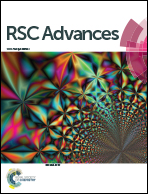Homogeneously magnetically concentrated silver nanoparticles for uniform “hot spots” in surface enhanced Raman spectroscopy†
Abstract
We report reproducible and sensitive surface-enhanced Raman spectroscopy (SERS) detection achieved with a developed nanoparticle platform, Ag&MH. Ag&MH is comprised of silver nanoparticles (AgNPs), as a sensing substrate that is efficiently and uniformly magnetically concentrated with the assistance of maghemite, γ-Fe2O3, nanoparticles (MHNPs). MNHPs were optimized synthetically for minimal charge interactions with AgNPs and low optical absorbance. At sufficiently high concentrations, magnetic maghemite NPs hydrodynamically trap AgNPs and concentrate them on the inner surface of a quartz optical cell to form an Ag&MH SERS substrate for highly reproducible SERS detection. The reproducibility is a combination of several factors contributing to uniform “hot spots”: homogeneous magnetic concentration by gentle hydrodynamic trapping and weak electrostatic interactions of the same-charge nanoparticles and non-close packing of AgNPs, in particular decahedra. Size-uniform silver decahedra nanoparticles (AgJ13NPs) featuring sharp localized surface plasmon resonance (LSPR) peaks, coupled with minimized optical interference from MHNPs, enable sensitive and reproducible SERS detection, where 5,5′-dithiobis-(2-nitrobenzoic acid), DTNB, was used as a probe molecule. Reproducibility of independent measurements at nanomolar level was ca. 10% – consistently overcoming the “hot spot” problem through uniform distribution of AgJ13NPs in the Ag&MH SERS substrate. Picomolar concentrations were detected using a simple fiber-optic Raman spectrometer. The developed AgJ13&MH sensing platform is promising for convenient and reproducible SERS detection of analytes in common laboratory settings.


 Please wait while we load your content...
Please wait while we load your content...